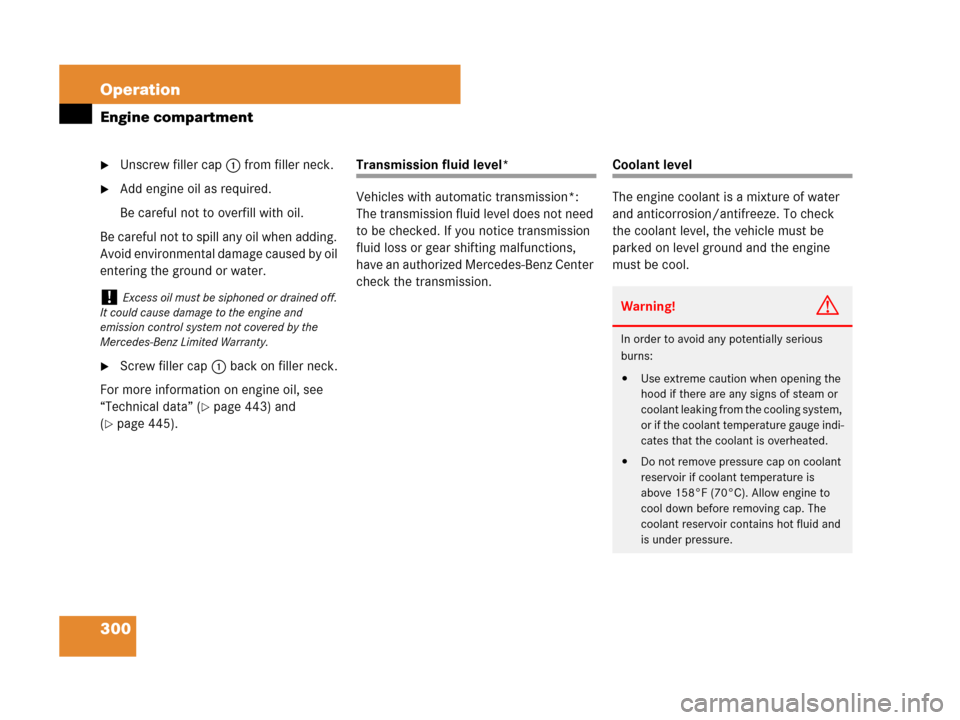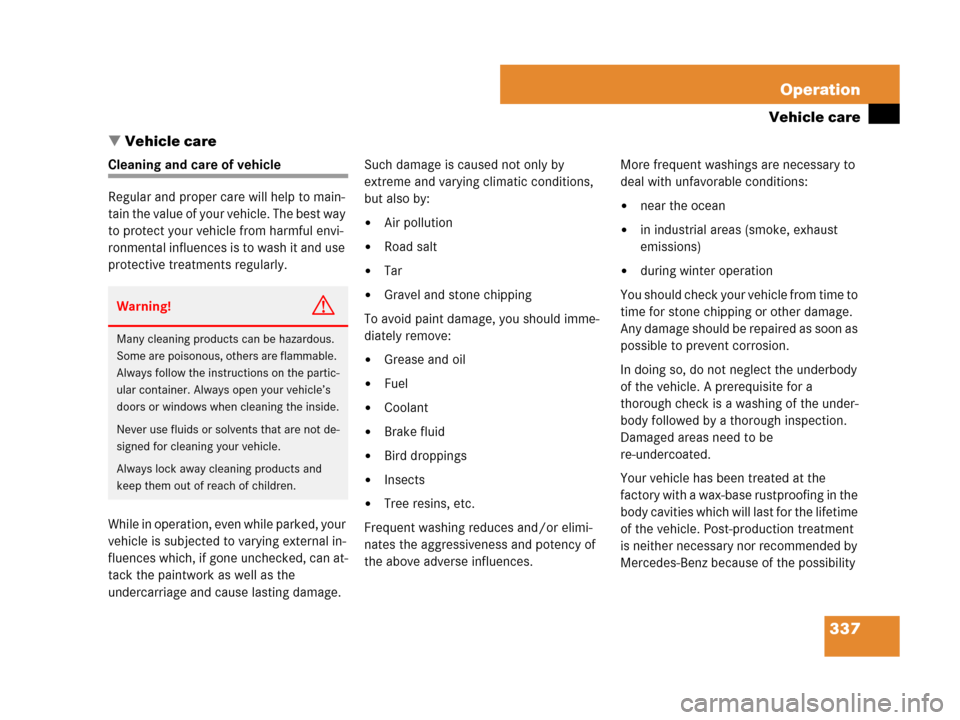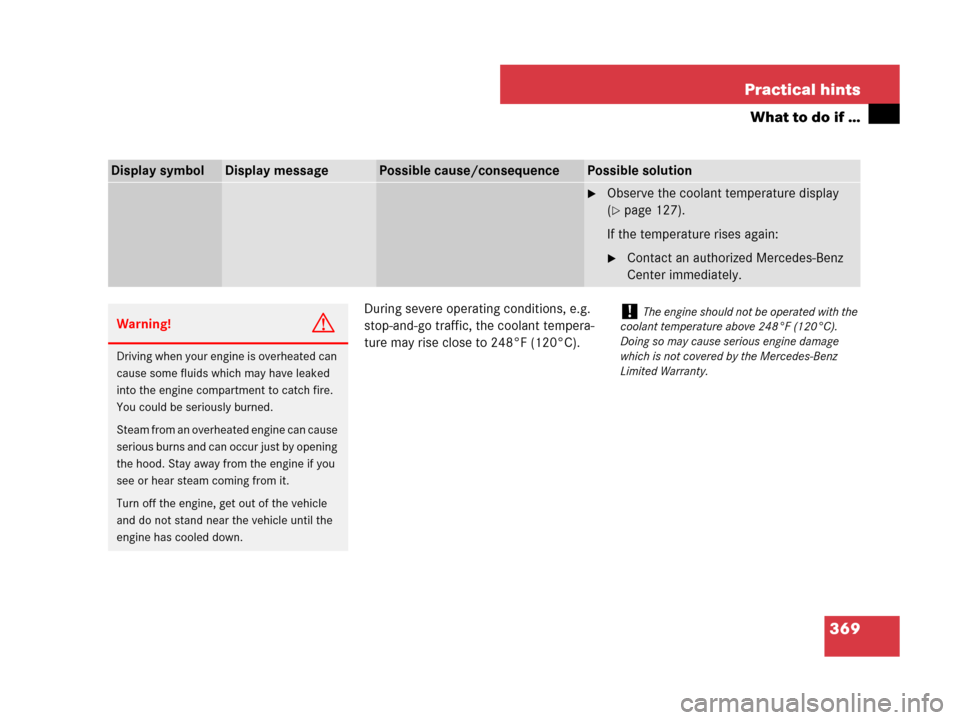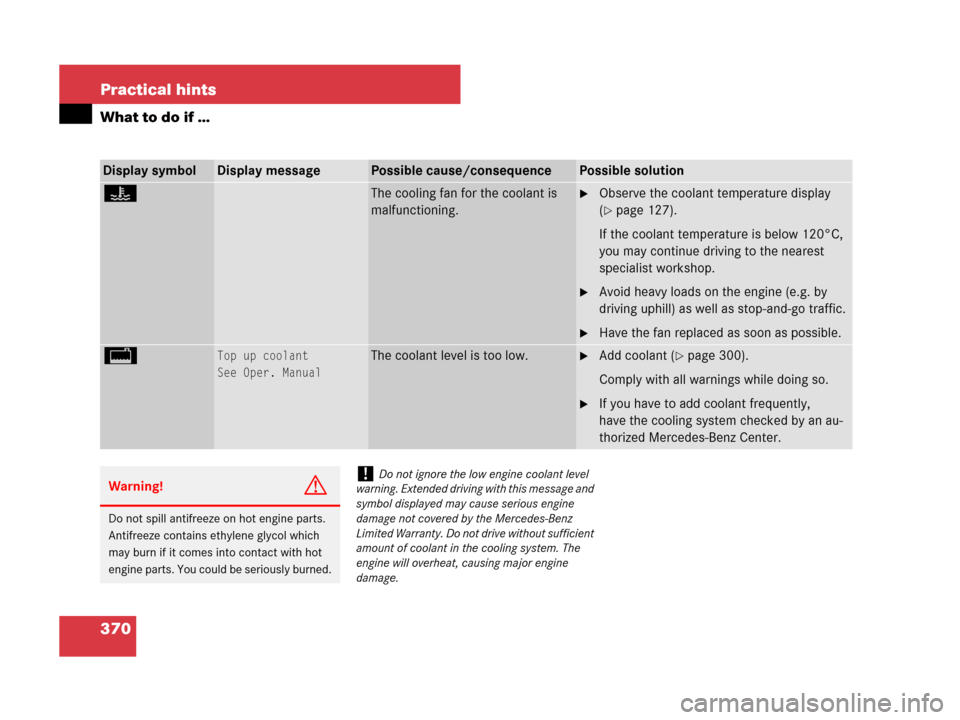Page 301 of 473

300 Operation
Engine compartment
�Unscrew filler cap1 from filler neck.
�Add engine oil as required.
Be careful not to overfill with oil.
Be careful not to spill any oil when adding.
Avoid environmental damage caused by oil
entering the ground or water.
�Screw filler cap1 back on filler neck.
For more information on engine oil, see
“Technical data” (
�page 443) and
(
�page 445).
Transmission fluid level*
Vehicles with automatic transmission*:
The transmission fluid level does not need
to be checked. If you notice transmission
fluid loss or gear shifting malfunctions,
have an authorized Mercedes-Benz Center
check the transmission.Coolant level
The engine coolant is a mixture of water
and anticorrosion/antifreeze. To check
the coolant level, the vehicle must be
parked on level ground and the engine
must be cool.
!Excess oil must be siphoned or drained off.
It could cause damage to the engine and
emission control system not covered by the
Mercedes-Benz Limited Warranty.Warning!G
In order to avoid any potentially serious
burns:
�Use extreme caution when opening the
hood if there are any signs of steam or
coolant leaking from the cooling system,
or if the coolant temperature gauge indi-
cates that the coolant is overheated.
�Do not remove pressure cap on coolant
reservoir if coolant temperature is
above 158°F (70°C). Allow engine to
cool down before removing cap. The
coolant reservoir contains hot fluid and
is under pressure.
Page 302 of 473
301 Operation
Engine compartment
The coolant expansion tank is located on
the passenger side of the engine compart-
ment.
SLK 350 (example illustration)
1Coolant expansion tank
2Cap
3Marking bar in the expansion tank
�Using a rag, turn cap2 slowly approx-
imately one half turn counterclockwise
to release any excess pressure.
�Continue turning cap2 counterclock-
wise and remove it.
The coolant level is correct if the level
�for cold coolant: reaches marking
bar3 in expansion tank1
�for warm coolant: is approximately
0.6 in (1.5 cm) higher
�Add coolant as required.
�Replace and tighten cap2.
For more information on coolant, see
“Coolants” (
�page 448).
�Using a rag, slowly open the cap approx-
imately 1/2turn to relieve excess pres-
sure. If opened immediately, scalding
hot fluid and steam will be blown out un-
der pressure.
�Do not spill antifreeze on hot engine
parts. Antifreeze contains ethylene
glycol which may burn if it comes into
contact with hot engine parts.
Page 329 of 473

328 Operation
Tires and wheels
Bar
Another metric unit for air pressure. There
are 14.5038 pounds per square inch (psi)
to 1 bar; there are 100 kilopascals (kPa)
to 1 bar.
Bead
The tire bead contains steel wires wrapped
by steel cords that hold the tire onto the
rim.
Cold tire inflation pressure
Tire inflation pressure when your vehicle
has been sitting for at least three hours or
driven no more than 1 mile (1.6 km).
Curb weight
The weight of a motor vehicle with stan-
dard equipment including the maximum
capacity of fuel, oil, and coolant, and, if so
equipped, air conditioning and additional
optional equipment, but without passen-
gers and cargo.DOT (Department of Transportation)
A tire branding symbol which denotes the
tire meets requirements of the
U.S. Department of Transportation.
GAWR (G
ross Axle Weight Rating)
The GAWR is the maximum permissible
axle weight. The gross vehicle weight on
each axle must never exceed the GAWR for
the front and rear axle indicated on the
certification label located on the driver’s
door B-pillar.
GVW (G
ross Vehicle Weight)
The GVW comprises the weight of the
vehicle including fuel, tools, spare wheel,
installed accessories, passengers and
cargo and, if applicable, trailer tongue
load. The GWV must never exceed the
GWVR indicated on the certification label
located on the driver’s door B-pillar.GVWR (G
ross Vehicle Weight Rating)
This is the maximum permissible vehicle
weight of the fully loaded vehicle (weight of
the vehicle including all options, passen-
gers, fuel, and cargo and, if applicable,
trailer tongue load). It is indicated on
certification label located on the driver’s
door B-pillar.
Kilopascal (kPa)
The metric unit for air pressure. There are
6.9 kPa to 1 psi; another metric unit for air
pressure is bars. There are 100 kilopascals
(kPa) to 1 bar.
Maximum load rating
The maximum load in kilograms and
pounds that can be carried by the tire.
Maximum loaded vehicle weight
The sum of curb weight, accessory weight,
total load limit and production options
weight.
Page 338 of 473

337 Operation
Vehicle care
�Vehicle care
Cleaning and care of vehicle
Regular and proper care will help to main-
tain the value of your vehicle. The best way
to protect your vehicle from harmful envi-
ronmental influences is to wash it and use
protective treatments regularly.
While in operation, even while parked, your
vehicle is subjected to varying external in-
fluences which, if gone unchecked, can at-
tack the paintwork as well as the
undercarriage and cause lasting damage.Such damage is caused not only by
extreme and varying climatic conditions,
but also by:
�Air pollution
�Road salt
�Tar
�Gravel and stone chipping
To avoid paint damage, you should imme-
diately remove:
�Grease and oil
�Fuel
�Coolant
�Brake fluid
�Bird droppings
�Insects
�Tree resins, etc.
Frequent washing reduces and/or elimi-
nates the aggressiveness and potency of
the above adverse influences.More frequent washings are necessary to
deal with unfavorable conditions:
�near the ocean
�in industrial areas (smoke, exhaust
emissions)
�during winter operation
You should check your vehicle from time to
time for stone chipping or other damage.
Any damage should be repaired as soon as
possible to prevent corrosion.
In doing so, do not neglect the underbody
of the vehicle. A prerequisite for a
thorough check is a washing of the under-
body followed by a thorough inspection.
Damaged areas need to be
re-undercoated.
Your vehicle has been treated at the
factory with a wax-base rustproofing in the
body cavities which will last for the lifetime
of the vehicle. Post-production treatment
is neither necessary nor recommended by
Mercedes-Benz because of the possibility
Warning!G
Many cleaning products can be hazardous.
Some are poisonous, others are flammable.
Always follow the instructions on the partic-
ular container. Always open your vehicle’s
doors or windows when cleaning the inside.
Never use fluids or solvents that are not de-
signed for cleaning your vehicle.
Always lock away cleaning products and
keep them out of reach of children.
Page 369 of 473
368 Practical hints
What to do if …
Display symbolDisplay messagePossible cause/consequencePossible solution
•Coolant
Stop, turn engine
offThe coolant is too hot.
Among other possible causes,
the poly-V-belt could be broken.�Stop the vehicle in a safe location or as soon as it is
safe to do so.
�Turn off the engine.
�Apply the parking brake (�page 59).
�Check the poly-V-belt.
If it is broken:
�Do not continue to drive. Otherwise, the engine will
overheat due to an inoperative water pump which
may result in damage to the engine. Contact an
authorized Mercedes-Benz Center.
If it is intact:
�Wait for the message to disappear before restarting
the engine.
Doing otherwise could result in serious engine
damage that is not covered by the Mercedes-Benz
Limited Warranty.
(Continued on next page)
Page 370 of 473

369 Practical hints
What to do if …
During severe operating conditions, e.g.
stop-and-go traffic, the coolant tempera-
ture may rise close to 248°F (120°C).
Display symbolDisplay messagePossible cause/consequencePossible solution
�Observe the coolant temperature display
(
�page 127).
If the temperature rises again:
�Contact an authorized Mercedes-Benz
Center immediately.
Warning!G
Driving when your engine is overheated can
cause some fluids which may have leaked
into the engine compartment to catch fire.
You could be seriously burned.
Steam from an overheated engine can cause
serious burns and can occur just by opening
the hood. Stay away from the engine if you
see or hear steam coming from it.
Turn off the engine, get out of the vehicle
and do not stand near the vehicle until the
engine has cooled down.
!The engine should not be operated with the
coolant temperature above 248°F (120°C).
Doing so may cause serious engine damage
which is not covered by the Mercedes-Benz
Limited Warranty.
Page 371 of 473

370 Practical hints
What to do if …
Display symbolDisplay messagePossible cause/consequencePossible solution
•The cooling fan for the coolant is
malfunctioning.�Observe the coolant temperature display
(
�page 127).
If the coolant temperature is below 120°C,
you may continue driving to the nearest
specialist workshop.
�Avoid heavy loads on the engine (e.g. by
driving uphill) as well as stop-and-go traffic.
�Have the fan replaced as soon as possible.
/Top up coolant
See Oper. ManualThe coolant level is too low.�Add coolant (�page 300).
Comply with all warnings while doing so.
�If you have to add coolant frequently,
have the cooling system checked by an au-
thorized Mercedes-Benz Center.
Warning!G
Do not spill antifreeze on hot engine parts.
Antifreeze contains ethylene glycol which
may burn if it comes into contact with hot
engine parts. You could be seriously burned.
!Do not ignore the low engine coolant level
warning. Extended driving with this message and
symbol displayed may cause serious engine
damage not covered by the Mercedes-Benz
Limited Warranty. Do not drive without sufficient
amount of coolant in the cooling system. The
engine will overheat, causing major engine
damage.
Page 372 of 473
371 Practical hints
What to do if …
Display symbolDisplay messagePossible cause/consequencePossible solution
±Display malfunction
Drive to workshopCertain electronic systems are un-
able to relay information to the con-
trol system. The following systems
may have failed:
�Coolant temperature display
�Tachometer
�Cruise control display
�Have the electronic systems checked by an
authorized Mercedes-Benz Center.
JYou are driving with one or more
doors open.�Close the doors.